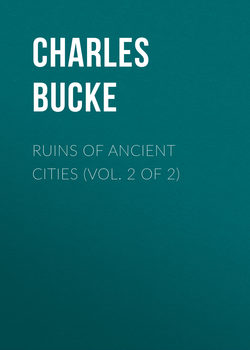Читать книгу Ruins of Ancient Cities (Vol. 2 of 2) - Charles Bucke - Страница 11
NO. XI. – PATRÆ
Оглавление“Night overtook us,” says Mr. Williams, “before we reached Patras, anciently called Patræ. But such a night! the moon was in full splendour; and while we travelled among the mysterious scenes, we were often tempted to pause and ask what could be those shadowy towers, that were perpetually arresting our attention? Nothing could be more pleasing or more romantic, than the winding of our cavalry among the projecting rocks and dismal hollows, when first a gleam of light prevailed, and then a solemn darkness veiled and softened all in sweet composure. The glow-worms, peeping from the bushes, seemed like fairies’ eyes; fireflies glanced in thousands, like the sun’s bright rays stealing on rippling waters in ebon shade; and how divine the evening star appeared, tipping the dark chain of Mount Olonos! The blackbird, too, with its train of dear associations, awakened our peculiar interest. All seemed, by their look of delight to say, ‘Sing on, sweet bird! and tell us of our absent friends and beloved country!’”
Patræ was a town of Peloponnesus, anciently called Aroe.
Diana had a temple there, and a statue formed of ivory and gold, which was considered a masterpiece. Apollo also had a temple, in which was a statue of the god, raised by Icadius.
In the time of Pausanias, Patræ was also adorned with porticoes, a theatre, and an odéum; the last of which was superior to any in Greece, with one exception, viz. that of Herodes Atticus at Athens. In the lower part of the city was a temple of Bacchus, in which was an image preserved in a chest. There was also one of Ceres, with a pleasant grove and a prophetic fountain, which determined the events of illness. After supplicating the goddess with incense, the sick person is said to have appeared, living or dead, in a mirror suspended so as to touch the surface of the water74.
Patræ was selected by Augustus as a place in which to settle some of those, who had fought with him at Actium. Some of the cities of Achaia were made tributary to the Patrenses, and they continued long to flourish after the decay of the neighbouring states.
They were rich in the monuments of art. Pausanias enumerates nineteen or twenty temples, besides statues, altars, and marble sepulchres, existing in his time in the city, the port, and the sacred groves.
Patras, though it has now recovered the destruction, was wholly destroyed by the Turks in 1770. We must, however, first state, that in 1447 it made the best defence against the Turks of any place in the Peloponnesus. In 1532 it was taken and ransacked by Doria. But of all its distresses the last was the most terrible; this was in 1770. It had lately been freed by the temporary success of Greek insurgents from the yoke of the Turks; but the appearance of the Athenians, who rushed through the passes of the isthmus to the assistance of the Mahometans, soon decided the fate of the place. An army of ten thousand, both horse and foot, entered the town through every avenue. It was not a contest, but a carnage: not a Greek capable of bearing arms was spared, and the houses were all burned to the ground75.
In forty years, Patras recovered this calamity, and is now said to be a flourishing place; but Mr. Dodwell describes it as being composed, like all other Turkish cities, of dirty and narrow streets; with houses built of earth, baked in the sun; with eaves overhanging the streets.
The few remains, which are in Patras, are of Roman construction; and those neither grand, interesting, nor well preserved. In the castle, however, there are said to be several beautiful forms of female statues: and here we have to state an instance of barbarism, strikingly illustrative of the character of the more ignorant portion of the Turks. Some marble columns and mutilated statues having been found, a few years ago, in the garden of a Turk, he immediately broke them to pieces!
There are several large fissures in the walls of the castle, occasioned by an earthquake, about forty years ago; in which forty persons were killed in the town, and thirteen crushed by the falling of one of the turrets.
“Nothing can be,” says Mr. Hobhouse, “more pleasant than the immediate vicinity of this town; which is one blooming garden of orange and lemon plantations, of olive groves, and currant grounds. The temple and the statues, the theatre, the columns and the marble porch, have disappeared: but the valleys and the mountains, and some, not frequent, fragments, of more value than all the costly monuments of barbaric labour, – these still remain, and remind the traveller, that he treads the ground once trod by the heroes and sages of antiquity. To traverse the native country of those, whose deeds and whose wisdom have been proposed to all the polished nations of every succeeding age, as the models which they should endeavour to imitate, but must never hope to equal, with no other emotions than would arise in passing through regions never civilised, is unnatural; is impossible! No one would roam with the same indifference through the sad solitudes of Greece, and the savage wilds of America; nor is the expression of feelings, which it is the object and end of all liberal education to instil and encourage, to be derided as the unprofitable effusion of folly and affectation.”76
74
Chandler.
75
Hobhouse.
76
Pausanias; Chandler; Rees; Hobhouse; Dodwell; Williams.
